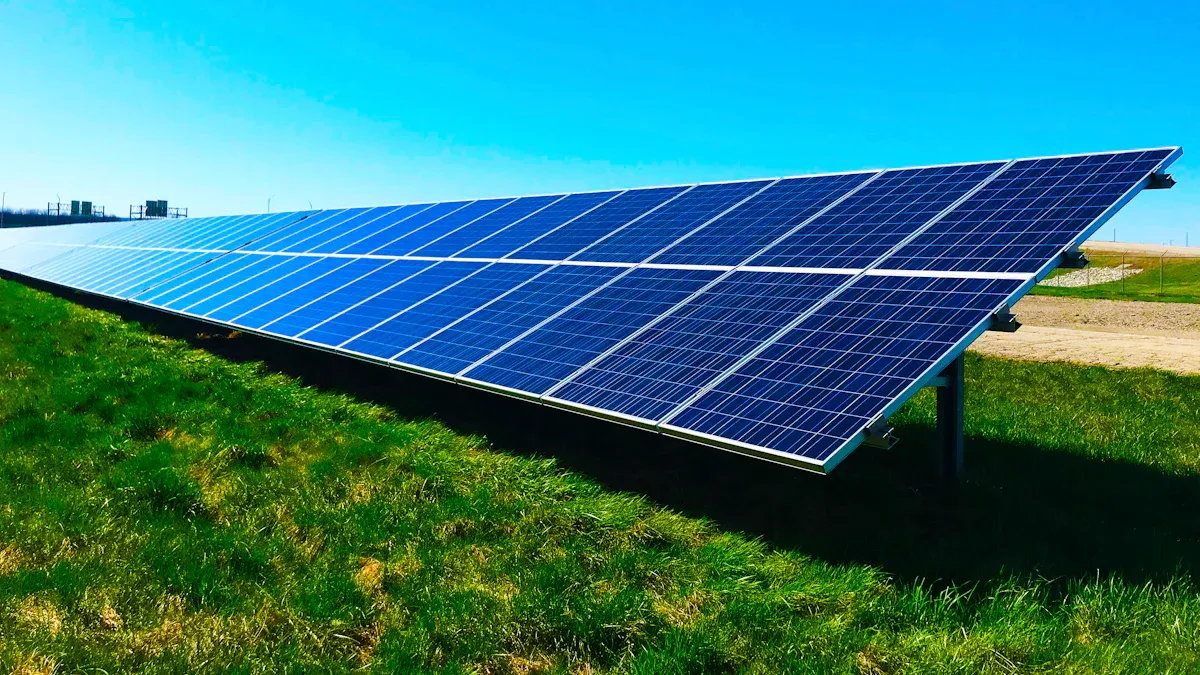
غرافيت شعرت ويؤدي دورا محوريا في تعزيز الكفاءة الحرارية في نظم تخزين الطاقة الشمسية. فخصائصها الفريدة، بما في ذلك السمية الحرارية العالية والاستقرار الكهروكيميائي، تجعل من الضروري لتكنولوجيات تخزين الطاقة المتقدمة. فعلى سبيل المثال، تستخدم بطاريات التدفق الأحمر بصورة متزايدة مسح الكربون و الكربون بسبب تكلفتها وقابليتها للتصعيد وبالإضافة إلى ذلك،, الألياف المضغوطة وكثيراً ما يُستخدم بالاقتران مع هذه المواد لتعظيم الأداء. وتتصدى هذه النظم لتحديات تخزين الطاقة، مما يدعم تزايد الطلب على الحلول المتجددة، لا سيما مع إدماجها الغرافيت المثبتة لتحسين الأداء.
المداخل الرئيسية
- شعرت (غرافيت) أنّها تساعد الطاقة الشمسية النظم تعمل بشكل أفضل من خلال توفير الحرارة.
- هو حرارة جيدة ويدوم طويلاً، يقطع نفايات الطاقة.
- إن تغيير سُمكها وكثافتها يجعلها تعمل على أفضل وجه في مختلف الاستخدامات.
ما هو (غرافيت فيلت)؟?
التعريف والامتيازات
شعر (غرافيت) أنه خفيف الوزنمواد خبيثة مستمدة من ألياف الكربون وهي تخضع لعملية علاجية ذات درجة عالية من الحرارة، تعزز من قدرتها على التصرف الحراري والكهربائي. وتظهر هذه المواد مقاومة استثنائية للتآكل الكيميائي ويمكنها تحمل درجات الحرارة القصوى، مما يجعلها مثالية لطلب التطبيقات. ويتكون هيكله من ألياف كربونية متشابكة، مما ينشئ منطقة سطحية كبيرة تدعم كفاءة نقل الحرارة وتخزين الطاقة. وبالإضافة إلى ذلك، يُعتبر الرسم البياني قابلاً للتكييف بدرجة كبيرة، مما يتيح للمصنعين أن يصمموا كثافته وسمكه لتلبية متطلبات محددة.
ملاءمة التطبيقات الحرارية
وشعرت غرافيت بأنها تبرهن على مدى ملاءمة التطبيقات الحرارية، لا سيما في نظم تخزين الطاقة. ويضمن ارتفاع معدل سلوكها الحراري توزيعا حراريا فعالا، في حين أن هيكله الخليع ييسر نقل الأيوني في العمليات الكهروكيميائية. وهذه الخصائص تجعل من الاختيار المفضل للتكنولوجيات مثل بطاريات التدفق وخلايا الوقود.
- وهي تعمل كهيئة فرعية تنفيذية، وتعزز نقل الأيوني، وتحسن كفاءة الشحن/القطع.
- وتدعم قدرتها الكبيرة على التخزين تخزين الطاقة في الأجل الطويل، وتعالج الطلب المتزايد على حلول الطاقة المتجددة.
- وقدرة المواد على الاحتفاظ بالحرارة ومقاومة التدهور تحت درجات الحرارة العالية تكفل استمرارية البيئات الصعبة.
ومع توسع نظم الطاقة المتجددة، لا يزال الطلب على الغرافيت يرتفع، مدفوعا بكفاءته وقابليته للتكيف في تخزين الطاقة الحرارية.
طلبات زملاء غرافيت في تخزين الطاقة الشمسية

الاستخدام في نظم الطاقة الشمسية المركزة
(غرافيت) شعر بلعبة حاسمة دور نظم الطاقة الشمسية المركزة من خلال تعزيز تخزين الطاقة الحرارية ونقلها. وتعتمد نظم نظام الأفضليات المعمم على القدرة على تخزين الحرارة وإطلاقها بكفاءة، وهو أمر أساسي لتوليد الكهرباء حتى عندما يكون ضوء الشمس غير متاح. وشعرت " غرافيت " ، مع ارتفاع مسيرتها الحرارية، بأنها تضمن نقل الحرارة التي يتم جمعها من مراكز الطاقة الشمسية بصورة فعالة إلى وسيطات تخزين مثل أملاح الرطبة أو مواد التغيير التدريجي. وتحسن هذه العملية الكفاءة العامة لنظم نظام الأفضليات المعمم.
كما أن الهيكل الخفيف للوزن والخلل من المواد يسهم في فعاليته في تطبيقات نظام الأفضليات المعمم. ويسمح بتحسين توزيع الحرارة ويقلل إلى أدنى حد من خسائر الطاقة أثناء التخزين والاسترجاع. وبإدماج الغرافيت المأخوذة في نظم نظام الأفضليات المعمم، يمكن للمشغلين أن يحققوا قدراً أكبر من الكفاءة في الاحتفاظ بالطاقة والإفراج عنها، بما يكفل اتساق إنتاج الطاقة.
السلوك الحراري واستدامة الحرارة
وشعرت المنهجية الحرارية الاستثنائية للغرافيت أن هذا الخيار المفضل لنظم تخزين الطاقة الشمسية. فقدرتها على إجراء الحرارة تكفل بكفاءة توزيع الطاقة بالتساوي عبر وسيطة التخزين، مما يقلل من خطر البؤر الساخنة والاختلالات الحرارية. وتتسم هذه السمة بأهمية خاصة في المنشآت الشمسية الواسعة النطاق، حيث يتسم الحفاظ على درجة الحرارة الموحدة بأهمية حاسمة بالنسبة لاستقرار النظام.
وشعرت غرافيت أيضا بالارتفاع في الاحتفاظ بالحرارة، وهو أمر حيوي لتخزين الطاقة لمدة طويلة. فهيكلها الخليوي يضخ الحرارة بفعالية، مما يتيح بقاء الطاقة المخزنة متاحة لفترات طويلة. ويسلط الجدول أدناه الضوء على مقاييس الأداء الرئيسية التي تبين أثر المواد على تخزين الطاقة الشمسية:
| مقاييس الأداء | الوصف |
|---|---|
| الطاقة | وشعرت غرافيت بأنها تعزز القدرة على الاحتفاظ بالطاقة في نظم التخزين. |
| كفاءة الإصدار | ويسمح تحسين كفاءة الإطلاقات بتحسين إنتاج الطاقة عند الحاجة. |
| الإدارة الحرارية | وتسهم الإدارة الحرارية الفعالة في استقرار النظام عموما. |
| كثافة الطاقة | زيادة كثافة الطاقة يجعل الرسوم البيانية خياراً مفضلاً للبطاريات. |
وتؤكد هذه القياسات على أهمية الغرافيت الذي يُشعر به في تحقيق الأداء الحراري لنظم الطاقة المتجددة.
الدوام في البيئات ذات الطبيعة العالية
غرافيت) شعر بمعارض) احتمالية كبيرة في ظل درجات الحرارة تجعلها مثالية لطلب تطبيقات الطاقة الشمسية يمكنه تحمل درجات حرارة تتجاوز 2000 درجة جيم بدون تدهور كبير، ضمان الموثوقية الطويلة الأجل في البيئات العالية الحرارة. وهذه القدرة على الصمود مفيدة بصفة خاصة في نظم نظام الأفضليات المعمم، حيث تتعرض المواد لحرارة شديدة أثناء عمليات جمع الطاقة وتخزينها.
وتزيد مقاومة المواد للتآكل الكيميائي من قدرتها على الاستمرار. وهي تحافظ على السلامة الهيكلية حتى عندما تتعرض لمواد تفاعلية، مع ضمان الأداء المتسق على مر الزمن. وباستخدام الغرافيت المشعر به، يمكن لنظم الطاقة الشمسية أن تحقق قدرا أكبر من طول التشغيل وتخفض تكاليف الصيانة.
Advantages of Graphite Felt in Renewable Energy Systems
كفاءة الطاقة والحد من فقدان الحرارة
Graphite felt significantly enhances كفاءة الطاقة في نظم الطاقة المتجددة عن طريق التقليل إلى أدنى حد من فقدان الحرارة أثناء تخزين الطاقة ونقلها. وتكفل سميتها الحرارية العالية توزيع الحرارة بالتساوي عبر وسائل التخزين، مما يقلل من نفايات الطاقة. وهذه الممتلكات تعود بالفائدة بصفة خاصة على المنشآت الشمسية الواسعة النطاق، حيث يكون الحفاظ على درجات حرارة ثابتة أمرا بالغ الأهمية للأداء الأمثل.
ويسهم الهيكل المجزأ للمواد أيضا في فعاليته. فهو يضخ الحرارة بكفاءة، مما يتيح بقاء الطاقة المخزنة متاحة لفترات طويلة. وتدعم هذه القدرة تخزين الطاقة في الأجل الطويل، وهو أمر أساسي لتلبية الطلب المتزايد على حلول الطاقة المتجددة. وبخفض فقدان الحرارة، تحسّن الغرافيت الكفاءة العامة لنظم الطاقة الشمسية، مما يجعلها أكثر موثوقية وفعالية من حيث التكلفة.
المنافع البيئية والمستدامة
وشعرت شركة Graphite أنها توفر العديد من المنافع البيئية والاستدامة، متوائمة مع الجهود العالمية الرامية إلى الحد من آثار الكربون. وكثيراً ما يتضمن إنتاجه المواد المعاد تدويرها، ويعزز الممارسات المراعية للبيئة. ويجري حاليا استكشاف تقنيات التصنيع المتقدمة، مثل طباعة 3D، للتقليل إلى أدنى حد من النفايات وانخفاض تكاليف الإنتاج. وتسهم هذه الابتكارات في استدامة المواد، مما يجعلها خيارا مفضلا لتطبيقات الطاقة المتجددة.
ويبرز الجدول الوارد أدناه الجوانب الرئيسية للأثر البيئي للغرافيت:
| Aspect | الأدلة |
|---|---|
| كفاءة الطاقة | ويُستخدم الكربون المشبوه في تكنولوجيات البطاريات، مما يعزز قدرات تخزين الطاقة. |
| الأثر البيئي | The use of carbon felt aligns with sustainability goals by minimizing carbon footprints. |
| الممارسات المراعية للبيئة | The production of carbon and graphite felts incorporates recycled materials, promoting sustainability. |
| الصناعة الابتكارية | ويجري استكشاف التقنيات المتقدمة مثل طباعة 3D للحد من النفايات وتخفيض تكاليف الإنتاج. |
وتبين هذه الصفات كيف أن الرسم البياني شعر بدعم الانتقال إلى نظم الطاقة الأنظف. كما أن استمراريتها وقابليتها للتكيف يزيدان من قيمتها البيئية، ويقللان من الحاجة إلى استبدالات متكررة، ويخفضان الاستهلاك العام للموارد. ويمكن للصناعات أن تحقق قدرا أكبر من الاستدامة في الوقت الذي تفي فيه بمطالب الطاقة، وذلك عن طريق إدماج الغرافيت في نظم الطاقة المتجددة.
Graphite Felt vs. Alternative Materials

مقارنة مع المواد الكيميائية
وتستخدم المواد الكيميائية على نطاق واسع في تطبيقات ذات درجات عالية بسبب استقرارها الحراري ومقاومتها للتآكل الكيميائي. ومع ذلك،, الغرافيت شعرت بالتفوق على السيراميك في عدة جوانب حاسمة. ويقلل هيكله الخفيف من وزن النظام عموما، مما يجعله أكثر ملاءمة للتطبيقات التي تتطلب تصميمات للتنقل أو الاتفاقات. وشعرت شركة Graphite أيضاً بأنها توفر قدرة على السير الحراري على نحو أفضل، بما يكفل كفاءة نقل الحرارة وتقليل خسائر الطاقة إلى أدنى حد خلال عمليات التخزين والاسترجاع.
الخلايا، في حين أنها دائمة، غالبا ما تظهر الرشوة تحت الضغط الميكانيكي. وشعرت غرافيت، بهيكلها المرن والمخرب، بأنها توفر قدرة أكبر على التكيف في البيئات الدينامية. وقابلية التكيف هذه تجعلها خياراً مفضلاً لنظم الطاقة المتجددة، حيث يجب أن تكون المواد ذات تقلبات حرارية وميكانيكية.
مقارنة مع بدائل المعادن
وتُستخدم المواد المعدنية، مثل النحاس والألومنيوم، عادة في التطبيقات الحرارية نظراً لارتفاع مرواها. ومع ذلك،, graphite felt offers distinct advantages فوق المعادن في نظم تخزين الطاقة الشمسية وخلافاً للمعادن، التي يمكن أن تتآكل بمرور الوقت، شعرت الغرافيت بأنها تقاوم التدهور الكيميائي، بما يكفل الموثوقية الطويلة الأجل. كما أن قدرتها على تحمل درجات حرارة متطرفة دون أن تذوب أو تمزقها تزيد من تعزيز ملاءمتها للبيئات العالية الحرارة.
والمعادن أثقل وأقل قدرة على التكيف مع الجيولوجيا المعقدة مقارنة بالغرافيت التي شعرت بها. والوزن الخفيف والطابع الذي يمكن تكييفه للغرافيت الذي يُشعر به يسمح للصانعين بتصميم نظم الطاقة بقدر أكبر من الكفاءة والدقة. وبالإضافة إلى ذلك، كثيراً ما تتطلب الفلزات المعاطف الواقية لمنع الأكسدة، مما يضيف إلى تكاليف الصيانة. وشعرت شركة Graphite بأنها تلغي هذه الحاجة، وتقليص النفقات التشغيلية، وتبسيط رفع مستوى النظام.
التكلفة والأثر البيئي
وتؤدي تكلفة المواد وتأثيرها البيئي دورا هاما في اعتمادها لنظم الطاقة المتجددة. وتظهر غرافيت مزايا في كلا المجالين. وفي حين أن تكاليف الإنتاج الأولية قد تكون أعلى بسبب تقنيات التصنيع المتقدمة، فإن استمراريتها الطويلة الأجل تعوض هذه النفقات بتخفيض الاحتياجات من الاستبدال والصيانة.
وقد ارتفعت تكاليف الامتثال البيئي للمواد البديلة، مثل السيراميات والفلزات، ارتفاعاً كبيراً بسبب أنظمة أشد صرامة للانبعاثات. وقد أدى تحسين أساليب الإنتاج للوفاء بهذه المعايير إلى زيادة التكاليف بمقدار 30-40%. وعلى النقيض من ذلك، فإن الرسم البياني يشعر بالاتساق مع أهداف الاستدامة، التي كثيرا ما تتضمن المواد المعاد تدويرها وعمليات التصنيع المبتكرة.
ويسلط الجدول الوارد أدناه الضوء على العوامل الرئيسية للتكلفة والبيئة:
| نوع الأدلة | التفاصيل |
|---|---|
| Environmental Compliance Costs | وزادت تكاليف تحسين أساليب الإنتاج لتلبية أنظمة الانبعاثات بنسبة 30-40%. |
| تكاليف التصديق | وتتطلب الحساسيات من الطراز النووي إجراء اختبارات وإصدار شهادات باهظة التكلفة، بتكلفة تتراوح بين 000 500 و 000 1 و 4 و 1 م. |
| الطلب على الأسواق | وارتفعت أسعار الشعائر الغرافيتية من درجة البطاريات 12% YoY بسبب زيادة الطلب من قطاع EV. |
وتبرز هذه العوامل الفوائد الاقتصادية والبيئية للغرافيت، مما يجعلها خيارا مقنعا لتطبيقات الطاقة المتجددة.
التحديات والمستقبل
القيود الحالية (مثلا، التكلفة، التوافر)
اعتماد الغرافيت شعرت وتواجه نظم تخزين الطاقة الشمسية عدة تحديات تتصل أساسا بالتكلفة والتوافر. ويؤثر تذبذب أسعار المواد الخام، ولا سيما بالنسبة للغرافيت وألياف الكربون، تأثيراً كبيراً على نفقات الإنتاج. وعملية التصنيع ذاتها عملية كثيفة التكلفة، وتتطلب آليات متقدمة وخبرة تقنية للخطوات من قبيل الكربون والرسم البياني والعلاج. وتسهم هذه العوامل في ارتفاع التكلفة الإجمالية لإنتاج الرسوم البيانية التي تشعر بها.
وبالإضافة إلى ذلك، لا يزال توافر الألياف الكربونية الميسورة التكلفة يشكل عقبة. ويقيِّد العرض المحدود للألياف الكربونية المنخفضة التكلفة التطبيق الأوسع للغرافيت التي تُحسَّن في نظم الطاقة المتجددة. كما أن المنافسة الحادة من المواد البديلة، مثل السيراميك والفلزات، تزيد من تعقيد وضعها السوقي. كما تفرض الأنظمة البيئية شروطا صارمة على عمليات الإنتاج، مما يزيد من تكاليف امتثال المصنعين. وتبرز هذه التحديات الحاجة إلى أساليب صناعية أكثر استدامة وفعالية من حيث التكلفة من أجل تعزيز إمكانية الوصول إلى الرسوم البيانية التي يُشعر بها.
الابتكارات والبحوث من أجل تحسين الأداء
البحوث الجارية وتوفر التطورات التكنولوجية حلولا واعدة للتغلب على هذه القيود. ويستكشف علماء المواد سلائف PAN (polyacrylonitrile) المعالجة بالبلازما، التي يمكن أن تقلل من وقت الفرن بمقدار 40% وتخفض الكربون المجسد بنسبة 34% لكل كيلوغرام. وهذه الابتكارات لا تقلل من تكاليف الإنتاج فحسب بل تتوافق أيضا مع أهداف الاستدامة.
تمثّل الألياف الضوئية ذات الأداء السطحي نجاحاً آخر وتظهر هذه الألياف قدرة أكبر على تحمل البروم ثلاث مرات، مما يجعلها أكثر استدامة وكفاءة للاستخدام في نظم تخزين الطاقة الشمسية. وتدل هذه التقدمات على الإمكانات التي يمكن أن تُحسَّن من الأداء مع معالجة الشواغل البيئية. ومن المرجح أن يؤدي استمرار الاستثمار في البحث والتطوير إلى فتح تطبيقات جديدة وتحسين القدرة التنافسية المادية في قطاع الطاقة المتجددة.
وقد ثبت أن غرافيت مادة تحولية في نظم تخزين الطاقة الشمسية. وتبرز قدرتها على تعزيز الكفاءة الحرارية والقدرة على الاستمرار في ظل ظروف متطرفة دورها الحاسم في النهوض بتكنولوجيات الطاقة المتجددة. فالابتكارات المقبلة، مثل تحسين تقنيات التصنيع، تعد بفتح إمكانيات أكبر حتى، بما يكفل استمرار أهميتها في حلول الطاقة المستدامة.
FAQ
ما الذي يجعل الأشعة تبدو مثالية لنظم تخزين الطاقة الشمسية؟?
(غرافيت) شعر بالعرض الحراري السلوك، والدوامة، ومقاومة درجات الحرارة القصوى. وهذه الممتلكات تجعلها مادة موثوقة لتخزين الطاقة وإدارة الحرارة بكفاءة.
هل يُمكن أن يُعاد تصميم الرسوم البيانية لتطبيقات محددة؟?
نعم, يمكن للمصنعين أن يضبطوا كثافتهسميكة، وسمكة ويكفل هذا التكييف الأداء الأمثل في مختلف نظم الطاقة المتجددة، بما في ذلك البطاريات ونظم الطاقة الشمسية المركزة.
كيف يشعر الرسم البياني بالإسهام في الاستدامة؟?
وشعرت غرافيت بأنه كثيرا ما يدمج المواد المعاد تدويرها وتقنيات التصنيع المتقدمة. وتخفض هذه الممارسات النفايات، وتخفض آثار الكربون، وتتفق مع أهداف الاستدامة العالمية.






